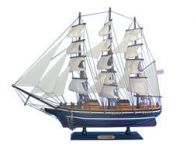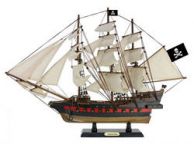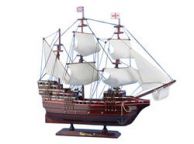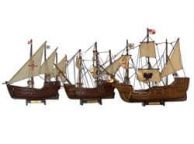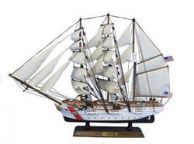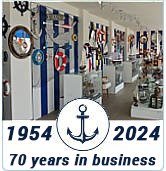|
|
> Page 6
| (335 Items) Sort: | Page: 1 2 3 4 5 6 7 | Show: / page |
| Page: 1 2 3 4 5 6 7 |
Tall Ship Models
Majestic, grandiose, inspiring, and free; those are just some of the words that come to mind when describing the beauty and might of a classic tall sailing ship. Named for the large masts and stunning collections of billowing sails, these amazing ships helped expand and redefine the world during the Age of Sail. Find your favorite tall ship model and enjoy the beautiful looks and masterful designs of Handcrafted Model Ships.
Nothing captures the history, romance and adventure of the open seas more than a fully-rigged tall ship plying the waves with a strong wind at her back. Full sails billowing in a steady breeze as sea spray washes the face of her crew, the tall ship is an icon of a past age.
Handcrafted Model Ships proudly offers a vast collection of tall ship models designed to appeal to every taste, purpose and budget. Encompassing an unmatched, world-spanning collection of history’s most famous tall ships, we offer sizes and options from small décor and commemoration models to Limited Edition museum quality replicas and even massive, unique Special Editions.
The term tall ship was actually not used during the Age of Sail, when all ships were, by their very nature as sailing vessels, required to be “tall” in order to carry sails upon their up-rising masts. Only when powerboats began to overtake them was the term retroactively applied to these classic sailing ships.
Tall Ship derives from the poem Sea-Fever, published in 1900 by English Poet Laureate John Masefield:
- I must go down to the sea again, to the lonely sea and the sky, All I ask is a tall ship and a star to steer her by.
Although a well-known nautical poem, the term did not enter common parlance until the mid-20th century, ironically at a celebration of the “end of the Age of Sail”. In 1956 London lawyer Bernard Morgan organized the first Tall Ships’ Race among 20 sailing ships to bid them a final farewell for their passage into history and obscurity. However, the event generated so much public interest and proved so popular that the race has been held annually ever since, and the term “tall ship” has entered the public consciousness to identify these mighty sailing ships.
Humans have been harnessing the power of the wind to sail boats since antiquity, but in ancient times the limitations of construction and seafaring technology meant that sails remained at best a companion to traditional oar-power. From the rowed biremes and triremes of ancient Greeks and Romans to the masted galleys of Medieval Europe, oarsmen remained critical to the operation of a vessel at sea.
This changed with the coming of the Age of Sail, starting 1571 when oar-propelled galleys played their last major naval role at the Battle of Lepanto. A key factor in the elimination of oarsmen was the refinement of naval cannon. Naval tactics from antiquity into the middle ages relied upon “ram-and-board” combat, when the ability to crash one ship headlong into the side of another regardless of the direction of the wind and thereafter immediately flood large hordes of combatants aboard was critical. Banks of oarsmen fulfilled both requirements.
However, the development of gunpowder and subsequent refinement of naval cannon allowed ships to engage in stand-off combat. Boarding was less important and eliminating galleries of rowers opened space for batteries of cannon. Thereafter, ever-larger and improving sailing ships were the height of maritime technology, and the era of the tall ship was born.
The Age of Sail overlapped with the Age of Exploration, when European tall ships plied all the world’s oceans, discovering and exploring new continents. Tall ships were not only warships, many were trade ships carry exotic goods or treasures between distant Far Eastern, African or American shore to Europe. As trade routes became more firmly established and distant lands better explored, tall ships launched the European Colonial Era. Settlers from Europe spread across the globe and established colonies in perhaps the larges human migration in recorded history.
With colonies spread across the globe, the empires of England, Spain, France, Holland and others required massive naval fleets to transport soldiers to guard their possessions or fight their wars, as well as to protect their trade routes and merchant shipping from raiding by pirates when they were not fighting one another. Naval vessels grew larger still as the cannon-loaded vessels developed the naval tactic known as the “line of battle”. Opposing fleets would simply string their ships into long lines and sail in opposite directions past one another, delivering devastating broadsides with their cannon as they passed. Ships engaged in these tactics were known as “ships of the line” and varied from massive First-Rate ships with three gun-decks and over 100 cannon down to the lowly Sixth-Rate whose mere 20 cannon limited her to participation in convoys, blockades, commerce-raiding or dispatch duties.
The line-of-battle remained the predominant naval tactic until the Napoleonic Era, when Admiral Lord Nelson of the British Royal Navy chose to divide his smaller fleet into twin lines led by his flagship the HMS Victory and use them to split the larger battle line of the superior Franco-Spanish forces. Throwing his opponents into chaos, he achieved England’s greatest naval victory of the war, disabling 22 enemy ships without losing a single British warship.
The mighty First-Rate warships were some of the largest, grandest, and in the case of vessels such as the British Sovereign of the Seas or the Spanish San Felipe the most ornate sailing ships ever constructed. However, a new age was dawning in the Post-Napoleonic Era, and the arrival of the clipper ships pushed tall ships into the Golden Age of Sail.
Long, sleek and fast, the clippers developed in the late 18th century with their three or more masts were long-distance, ocean-going, trans-continental trade ships. Their cargoes included Chinese tea bound for Europe, California gold rounding Cape Horn on its way to the US Eastern Seaboard, salmon from Alaskan fisheries headed to southern markets, and all manner of other goods traveling between major European or American ports and distant locations in the Orient, Australia or South Pacific.
With the clipper ships and their later derivatives the iron-hulled windjammers, sailing technology reached its peak in terms of speed, power and performance. However, experiments with steam-powered vessels had begun nearly a century earlier and by the early 1800s regular steamship service had been established along the protected waterways of rivers and lakes. Before long, steam engines became reliable and powerful enough to adapt to ocean-going vessels as well.
The Age of Sail finally drew to a close in 1862 when the ironclad and steam-powered USS Monitor faced off against the CSS Virginia at the Battle of Hampton Roads. Although tall ships would linger on in limited service as long-haul cargo vessels and fishing boats for nearly another century, their days were clearly numbered as the era of the steamship arrived.
Nevertheless, as Mr. Morgan learned in 1956, classic tall ships have never truly faded from popular interest. Their appeal continues to excite the romance and imagination of enthusiasts today, and many events in addition to the Tall Ships’ Races celebrate their heritage. Various races and exhibitions of tall ships remain popular, including the annual Tall Ships Challenge in North America which rotates between Great Lakes, Atlantic and Pacific courses or the intermittent Operation Sail events sponsored by the US Congress to commemorate significant events in American maritime or naval history. Meanwhile, tall ships such as the USS Constitution or USCGC Eagle tour the world as goodwill ambassadors for their country.
 Handcrafted
Handcrafted Handcrafted
Handcrafted Handcrafted
Handcrafted Handcrafted
Handcrafted Handcrafted
Handcrafted Handcrafted Model Ships
Handcrafted Model Ships






















